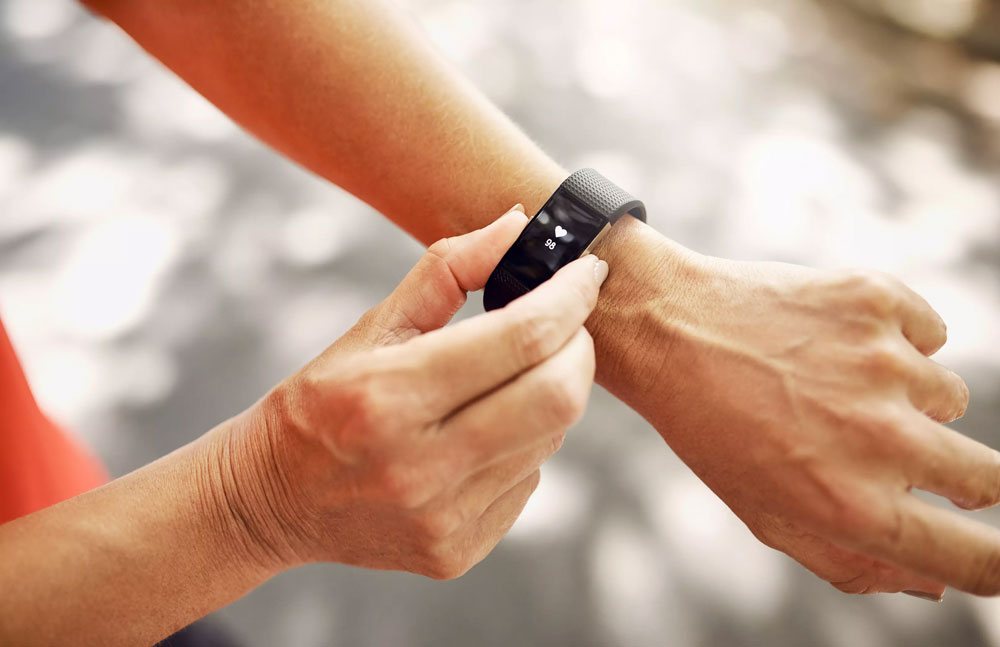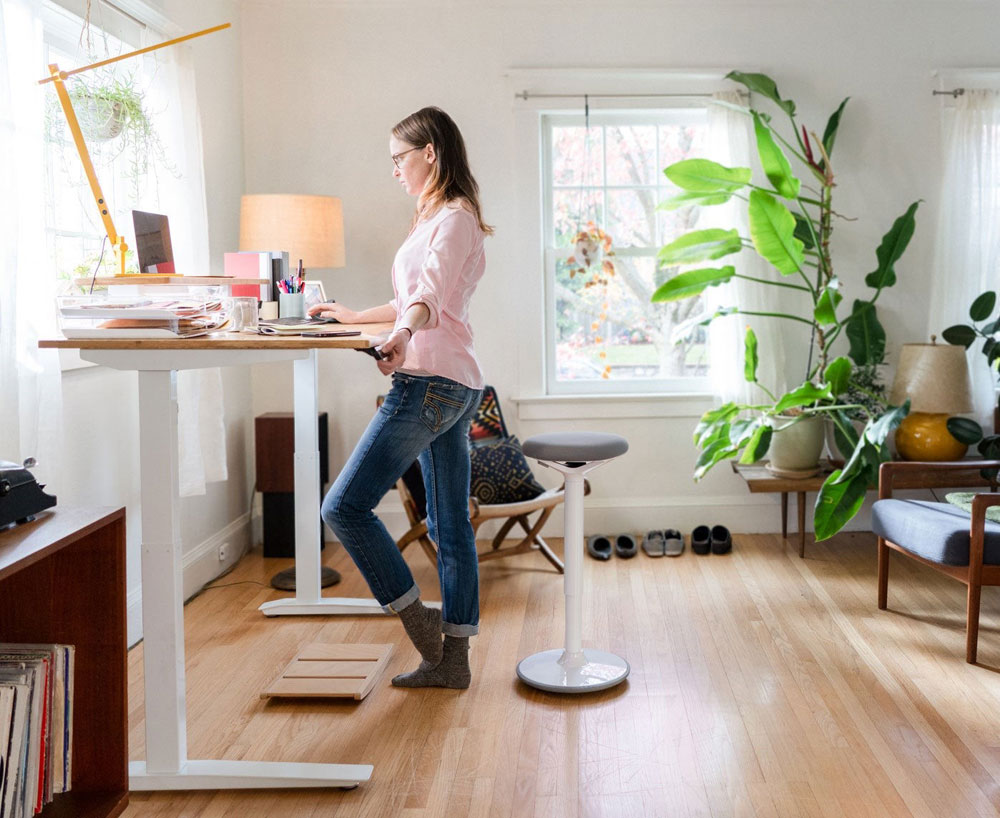Thomas Jefferson Desk

Working whilst standing isn’t really something new. After all we can trace back the use of standing desks to the 1700s where Thomas Jefferson would use his ‘tall desk’. It featured a slanted top which could be adjusted on a ratchet. Novelist, Ernerst Hemingway would write whilst standing, so would Winston Churchill at home, and the writer Virginia Woolf according to her nephew and biographer Quentin Bell.
We can see over the decades that standing when presenting or speaking also holds a certain authority over those who are seated. We can see through research that authority is determined by relative height. Standing up takes authority naturally without having to be pushy. Sitting down gives it up or at least creates a different atmosphere. Perhaps one that is more conversational and a situation where open debate is welcome.
Perhaps this is why you’ll find many salespeople, traders or people who need to make important decisions pacing the hallways of the office or standing to exude a more natural confidence in the way they speak. If you are looking to demonstrate a more confident air when talking to colleagues, or when presenting a webinar then easily adjusting your workstation to a standing position could be beneficial.
Standing whilst working isn’t new, just the way we speak about it might be. We now have much evidence to show the physical benefits of standing throughout the day.
Sitting for long periods has been linked to diseases such as obesity, diabetes, cardiovascular disease, cancer and premature death. The rise in the use of standing desks means that the standing desk market is likely to reach $2.8 Billion by 2025. As of 2016, the market is led collectively by the mechanically adjustable and converter standing desks segment.

Whilst there is a rise in the use of standing desks it should be noted that these are just an intervention to reduce sitting time. There is evidence to show the benefits of standing, it just may not be the full solution to people’s sedentary lifestyles. Recently published research by Dr Chris van Tullekan has shown some significant insights into the effects of using a standing desk. One of which is when standing participants had a tiny increase in their heart rate which, when averaged over the days, weeks and months leads to the equivalent number of calories burned as if they’d run about 10 marathons in the year.
In real terms though this means that when standing, people burn approximately an additional 8 calories an hour than if they were seated. If weight loss is your goal, then just the act of standing may not yield significant enough results for you. Walking though for 30 minutes has been shown to burn approximately 100 calories so pacing around the office, taking phone calls whilst walking or going out for a lunch time stroll might be more impactful for weight loss.

The other significant finding from Dr van Tullekan’s research was that those who were standing were able to clear the sugar out of their blood stream more quickly than when they were sitting down; this is usually seen in people who demonstrate active lifestyles. Anecdotally many people do say that using a standing desk helps to reduce the onset of back, neck and shoulder pain. It allows them to stretch their body and get out of a sometimes-awkward seated posture to be able to readjust themselves and create a more neutral posture.
A neutral posture is a position that supports the natural curves of the spine and maintain your body in good alignment. A position of ease for the body to sustain with minimal effort. This is much easier to do in a standing position or when lying flat on your back as the curvatures of the spine are naturally supported. When seated, especially in a slouched position kyphosis of the spine can occur which creates a ‘C’ shape like posture of the spine. This type of posture can put unnecessary strain on the lower back and cause discomfort or pain.
There are two popular types of desks at the moment that help to create a standing position; a mechanical and electrical desk or a “on the desk top” solution.
Electric desks can be beneficial, as with a touch of a button you have the ability to move the desk from a seated to standing position. This can take a mere few seconds, so with that in mind there really is no excuse not to stand throughout the day when it is so easy to do so. Some electric desks also have a small digital screen which can show you the height of the desk. You can programme the perfect position for when you are seated and standing which also reduces the time needed to adjust your workstation.


Just make sure you are adjusting the height of your desk to suit you properly because if you don’t there could be other risk factors that occur. For example, if your desk is too high this can cause shoulder shrugging, and this is one of the leading causes of tension across the neck and shoulders.
Electric desks whilst are a great option and have significantly reduced in price over the years are still an investment. They even at their smallest specification create a large footprint in the space you are working from. An alternative option might be an on the desk top solution. These can be placed on top of the desk you already have and instantly allow you the ability to move from a seated position to a standing position.
They are much more cost effective then a fully adjustable electric desk and they can take up less space. They are usually designed with handles on either side that you can use to lift the device up or down to suit your needs. Make sure you look for one that is not too heavy to lift up or down as you don’t want to cause yourself additional injury to your body by lifting a heavy device and don’t forget to set it at the right height for you to avoid shoulder shrugging.
A good rule of thumb is when your hands are in your lap or by your side when standing that the desk top height meets your natural elbow position. This will allow you to sit or stand comfortably without having to shrug your shoulders to reach your keyboard and mouse. Of course, follow this up by setting your monitors at eye level or just below and about an arm’s length away. Keep your keyboard and mouse close to you to avoid any unnecessary stretching of your arms.
Standing certainly has its benefits. It can support a more neutral posture of the spine, encourage people to stretch, roll their shoulders back and generally fidget a bit more increasing blood circulation around the body as well as oxygen levels. It should be noted though that people have different thresholds when it comes to standing. Some will be able to stand for longer periods and others will need to sit after 10 minutes.
There is really no significant research that gives us an exact time frame to sit and stand. The consensus is to move between different postures regularly. Professor Emeritus Alan Hedge suggest 20 minutes sitting, 8 minutes standing and 2 minutes moving. Some people find this to be a bit too distracting and may opt for a 5-10-minute break from sitting every 50 minutes. Although researcher Leon Straker’s research has shown that people can stand for up to 45 minutes at a time without harming themselves.
The different time frames for sitting, standing and moving may be confusing but I would urge everyone to listen to their body. As an ergonomist with 10 years’ experience and lots of stories to share, anecdotally I’ve found that people fair well when they sit for around 35-40 minutes and stand for 20-25 minutes with some movement breaks in between. Having said that I would listen to your body and don’t do either for longer than an hour as that is when we start to see the onset of fatigue and further musculoskeletal issues. Your goal should be to move between different postures before the onset of fatigue or any feelings of discomfort and pain.